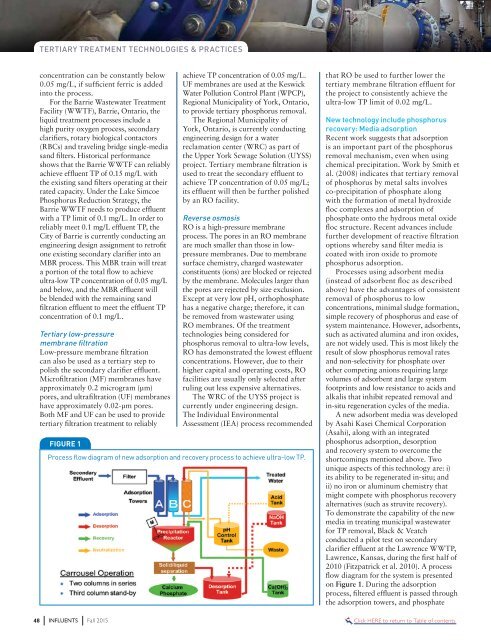lauren@kelman.ca
1YLWYxL
1YLWYxL
Create successful ePaper yourself
Turn your PDF publications into a flip-book with our unique Google optimized e-Paper software.
TERTIARY TREATMENT TECHNOLOGIES & PRACTICES<br />
concentration <strong>ca</strong>n be constantly below<br />
0.05 mg/L, if sufficient ferric is added<br />
into the process.<br />
For the Barrie Wastewater Treatment<br />
Facility (WWTF), Barrie, Ontario, the<br />
liquid treatment processes include a<br />
high purity oxygen process, secondary<br />
clarifiers, rotary biologi<strong>ca</strong>l contactors<br />
(RBCs) and traveling bridge single-media<br />
sand filters. Histori<strong>ca</strong>l performance<br />
shows that the Barrie WWTF <strong>ca</strong>n reliably<br />
achieve effluent TP of 0.15 mg/L with<br />
the existing sand filters operating at their<br />
rated <strong>ca</strong>pacity. Under the Lake Simcoe<br />
Phosphorus Reduction Strategy, the<br />
Barrie WWTF needs to produce effluent<br />
with a TP limit of 0.1 mg/L. In order to<br />
reliably meet 0.1 mg/L effluent TP, the<br />
City of Barrie is currently conducting an<br />
engineering design assignment to retrofit<br />
one existing secondary clarifier into an<br />
MBR process. This MBR train will treat<br />
a portion of the total flow to achieve<br />
ultra-low TP concentration of 0.05 mg/L<br />
and below, and the MBR effluent will<br />
be blended with the remaining sand<br />
filtration effluent to meet the effluent TP<br />
concentration of 0.1 mg/L.<br />
Tertiary low-pressure<br />
membrane filtration<br />
Low-pressure membrane filtration<br />
<strong>ca</strong>n also be used as a tertiary step to<br />
polish the secondary clarifier effluent.<br />
Microfiltration (MF) membranes have<br />
approximately 0.2 microgram (μm)<br />
pores, and ultrafiltration (UF) membranes<br />
have approximately 0.02-μm pores.<br />
Both MF and UF <strong>ca</strong>n be used to provide<br />
tertiary filtration treatment to reliably<br />
FIGURE 1<br />
achieve TP concentration of 0.05 mg/L.<br />
UF membranes are used at the Keswick<br />
Water Pollution Control Plant (WPCP),<br />
Regional Municipality of York, Ontario,<br />
to provide tertiary phosphorus removal.<br />
The Regional Municipality of<br />
York, Ontario, is currently conducting<br />
engineering design for a water<br />
reclamation center (WRC) as part of<br />
the Upper York Sewage Solution (UYSS)<br />
project. Tertiary membrane filtration is<br />
used to treat the secondary effluent to<br />
achieve TP concentration of 0.05 mg/L;<br />
its effluent will then be further polished<br />
by an RO facility.<br />
Reverse osmosis<br />
RO is a high-pressure membrane<br />
process. The pores in an RO membrane<br />
are much smaller than those in lowpressure<br />
membranes. Due to membrane<br />
surface chemistry, charged wastewater<br />
constituents (ions) are blocked or rejected<br />
by the membrane. Molecules larger than<br />
the pores are rejected by size exclusion.<br />
Except at very low pH, orthophosphate<br />
has a negative charge; therefore, it <strong>ca</strong>n<br />
be removed from wastewater using<br />
RO membranes. Of the treatment<br />
technologies being considered for<br />
phosphorus removal to ultra-low levels,<br />
RO has demonstrated the lowest effluent<br />
concentrations. However, due to their<br />
higher <strong>ca</strong>pital and operating costs, RO<br />
facilities are usually only selected after<br />
ruling out less expensive alternatives.<br />
The WRC of the UYSS project is<br />
currently under engineering design.<br />
The Individual Environmental<br />
Assessment (IEA) process recommended<br />
Process flow diagram of new adsorption and recovery process to achieve ultra-low TP.<br />
48 INFLUENTS Fall 2015<br />
that RO be used to further lower the<br />
tertiary membrane filtration effluent for<br />
the project to consistently achieve the<br />
ultra-low TP limit of 0.02 mg/L.<br />
New technology include phosphorus<br />
recovery: Media adsorption<br />
Recent work suggests that adsorption<br />
is an important part of the phosphorus<br />
removal mechanism, even when using<br />
chemi<strong>ca</strong>l precipitation. Work by Smith et<br />
al. (2008) indi<strong>ca</strong>tes that tertiary removal<br />
of phosphorus by metal salts involves<br />
co-precipitation of phosphate along<br />
with the formation of metal hydroxide<br />
floc complexes and adsorption of<br />
phosphate onto the hydrous metal oxide<br />
floc structure. Recent advances include<br />
further development of reactive filtration<br />
options whereby sand filter media is<br />
coated with iron oxide to promote<br />
phosphorus adsorption.<br />
Processes using adsorbent media<br />
(instead of adsorbent floc as described<br />
above) have the advantages of consistent<br />
removal of phosphorus to low<br />
concentrations, minimal sludge formation,<br />
simple recovery of phosphorus and ease of<br />
system maintenance. However, adsorbents,<br />
such as activated alumina and iron oxides,<br />
are not widely used. This is most likely the<br />
result of slow phosphorus removal rates<br />
and non-selectivity for phosphate over<br />
other competing anions requiring large<br />
volumes of adsorbent and large system<br />
footprints and low resistance to acids and<br />
alkalis that inhibit repeated removal and<br />
in-situ regeneration cycles of the media.<br />
A new adsorbent media was developed<br />
by Asahi Kasei Chemi<strong>ca</strong>l Corporation<br />
(Asahi), along with an integrated<br />
phosphorus adsorption, desorption<br />
and recovery system to overcome the<br />
shortcomings mentioned above. Two<br />
unique aspects of this technology are: i)<br />
its ability to be regenerated in-situ; and<br />
ii) no iron or aluminum chemistry that<br />
might compete with phosphorus recovery<br />
alternatives (such as struvite recovery).<br />
To demonstrate the <strong>ca</strong>pability of the new<br />
media in treating municipal wastewater<br />
for TP removal, Black & Veatch<br />
conducted a pilot test on secondary<br />
clarifier effluent at the Lawrence WWTP,<br />
Lawrence, Kansas, during the first half of<br />
2010 (Fitzpatrick et al. 2010). A process<br />
flow diagram for the system is presented<br />
on Figure 1. During the adsorption<br />
process, filtered effluent is passed through<br />
the adsorption towers, and phosphate<br />
Click HERE to return to Table of contents


